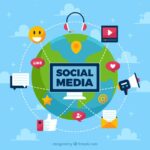Why Indian Social Media Failed Abruptly?
In terms of monthly active users, these are the largest social media platforms in the world. As we all know Indians are the largest user base for most of these platforms. But there is something else that you might have noticed here. There is not a single Indian social media platform on this list.

Why is it that a country with the world’s largest population and second-largest online population has failed to build a social media platform of its own?
There is clearly a huge opportunity, but why have Indian entrepreneurs ignored it? The truth is, they have tried. Remember Hike Messenger? It was a WhatsApp competitor. At its peak, it even had one hundred million users. But after fighting a lost battle with WhatsApp for almost a decade, the app was shut down in 2021. Then there is Mohalla Tech, the company that owns both Sharechat and Moj. They have over 325,000,000 monthly active users combined. However, the company is close to running out of money. Then there is a whole graveyard of short video apps, like Chingari, Mitro TV, Roposo, Bolo India, and Josh. After TikTok was banned in 2020, they had a fantastic run. But today, some of them have shut down, and others have pivoted and there are a few that are still using the fuel to fight a losing battle, which, by the way, has already been won by Instagram reels and YouTube shorts.When I look at the evolution of social media, I see that there are mainly two social media waves. The first one was in the early 2000s when the Internet was just becoming mainstream in countries like the US and many of the successful social media apps that we see today were launched during this time. Facebook, Twitter, WhatsApp, and Instagram. All of these apps were developed in the United States during the first decade of this century. Additionally, there was an entire ecosystem for the development and expansion of these apps in the United States, both in terms of talent and investment. And India at that time lacked both of these things.
Firstly, we did not have a startup ecosystem at that time and because of that, talented Indians who could build these apps were building them in the US, as that’s where they got the ecosystem to build them. The absence of a market in India at the time is an additional significant factor. Less than 10% of Indians were using the Internet and because of these reasons, India completely failed to capitalize on the first wave of social media apps.
The second wave of social media began in 2016, not in the US, but in China. It started with the arrival of TikTok, which changed the face of social media forever and there were certain reasons why this happened in China. You see, by now, China had become the world’s largest digital market, with over 500 million smartphone users, which was twice the amount of US smartphone users. Also, China has been trying for more than a decade to compete with the US products and they finally succeeded with TikTok. The expansion of TikTok was unprecedented. By 2020, it had 700 million monthly active users, making it the fastest app to reach 100 million users in just nine months. And Chinese users alone were not responsible for that. TikTok also became a big thing in India. Out of these 700 million users, 150,000,000 of them were in India.




